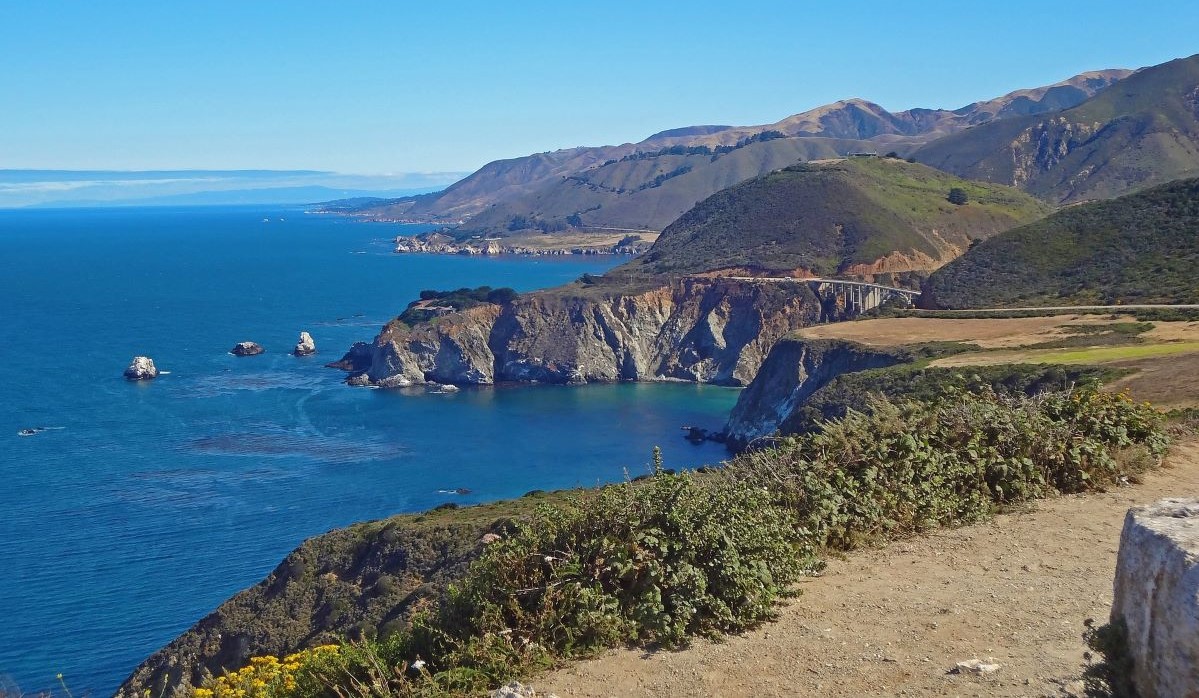In California water news this weekend …
More unsettled weather takes aim at West Coast
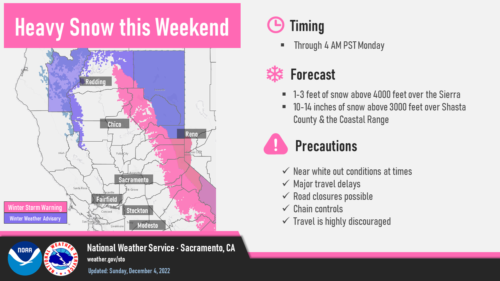 “Most along the West Coast have been no stranger to unsettled weather as of late, with frequent rounds of cold rain near the coasts, heavy snow at higher elevations, and strong winds ripping through many regions. As yet another storm impacts the coast this weekend, AccuWeather forecasters say more of the same will be in store through the new week, with more opportunities for beneficial rainfall up and down the coast. “This storm will hover just offshore through the day Sunday, close enough to funnel a substantial amount of moisture into California,” AccuWeather Senior Meteorologist Alex Sosnowski explained. … ” Read more from AccuWeather here: More unsettled weather takes aim at West Coast
“Most along the West Coast have been no stranger to unsettled weather as of late, with frequent rounds of cold rain near the coasts, heavy snow at higher elevations, and strong winds ripping through many regions. As yet another storm impacts the coast this weekend, AccuWeather forecasters say more of the same will be in store through the new week, with more opportunities for beneficial rainfall up and down the coast. “This storm will hover just offshore through the day Sunday, close enough to funnel a substantial amount of moisture into California,” AccuWeather Senior Meteorologist Alex Sosnowski explained. … ” Read more from AccuWeather here: More unsettled weather takes aim at West Coast
Desalination: Cal Am faces tough road ahead to meet Coastal Commission conditions
“While California American Water Co. and its supporters certainly won a major victory when the California Coastal Commission recently green-lighted its desalination project, it might be a bit early for the company to start popping champagne corks. There are numerous challenges ahead. Lawsuits, other regulatory hurdles and significant conditions the Coastal Commission placed on its approval could take years for Cal Am to wade through before a single shovel of dirt is turned – not to mention the hundreds of millions of dollars it will take before the project reaches fruition. The legal hurdles themselves will be hard to overcome and one or more could doom the project should Cal Am lose in court. Perhaps the most closely watched is a pending lawsuit entitled City of Marina v. RMC Lonestar. … ” Continue reading at the Monterey Herald here: Desalination: Cal Am faces tough road ahead to meet Coastal Commission conditions | Read via MSN News
VIDEO: Westlands longtime GM Birmingham believes it’s right time to retire, claims if he stayed it would have created conflict and distraction
California’s almond groves shrink as water supply dwindles
 “California farms that supply 80% of the world’s almonds are shrinking for the first time in more than a quarter century as the state’s historic drought leads farmers to abandon orchards or forgo new plantings altogether. The state had an estimated 1.64 million acres at the end of August, down slightly from a year earlier, according to the Almond Board of California. Further, the number of new trees planted from 2020 but are not yet bearing almonds fell 17%. California’s driest three-year period on record has spurred unprecedented cuts to usual water supplies, driving up costs. That’s forcing some producers to tear out orchards in favor of other crops, or simply stop watering trees. Production in the 2022-2023 season is expected to drop 11%, according to the US Department of Agriculture. … “ Read more from Bloomberg here: California’s almond groves shrink as water supply dwindles
“California farms that supply 80% of the world’s almonds are shrinking for the first time in more than a quarter century as the state’s historic drought leads farmers to abandon orchards or forgo new plantings altogether. The state had an estimated 1.64 million acres at the end of August, down slightly from a year earlier, according to the Almond Board of California. Further, the number of new trees planted from 2020 but are not yet bearing almonds fell 17%. California’s driest three-year period on record has spurred unprecedented cuts to usual water supplies, driving up costs. That’s forcing some producers to tear out orchards in favor of other crops, or simply stop watering trees. Production in the 2022-2023 season is expected to drop 11%, according to the US Department of Agriculture. … “ Read more from Bloomberg here: California’s almond groves shrink as water supply dwindles
Extreme drought means meager portions for California water agencies
“California water officials have announced public water agencies will be receiving 5% of the water they’ve requested for 2023, thanks to what is expected to be the fourth year of extreme drought. It is only the initial allocation from the State Water Project — more water could be sent to local agencies later in the year if conditions improve. “This early in California’s traditional wet season, water allocations are typically low due to uncertainty in hydrologic forecasting,” Karla Nemeth, director of the California Department of Water Resources, said in a statement. “But the degree to which hotter and drier conditions are reducing runoff into rivers, streams and reservoirs means we have to be prepared for all possible outcomes.” … ” Read more from the Courthouse News here: Extreme drought means meager portions for California water agencies
California Farm Bureau responds to initial 5% allocation of water from state
“California water agencies that serve 27 million people will get just 5% of what they requested from the California Department of Water Resources to start 2023. The Thursday announcement from water officials of the limited water comes as California concludes its driest three-year stretch on record and as water managers brace for a fourth year with below-average precipitation. But if the winter is wetter than expected, the state could boost how much supply it plans to give out — as it did last year when allocations started at 0% and ended the winter at 5%. 2021 also yielded a final allocation of 5%. “Here we go again,” stated California Farm Bureau President Jamie Johansson. “This means that 23 million people and 750,000 acres of farmland are facing another year of uncertainty and economic hardships. California has failed to act on critical projects to provide additional water storage, stormwater capture and groundwater recharge that are needed to protect our farms and cities from water shortages in dry years. … ” Read more from the Daily Democrat here: California Farm Bureau responds to initial 5% allocation of water from state
In-person public comment meeting in Hood, CA will focus on Delta Tunnel project EIR
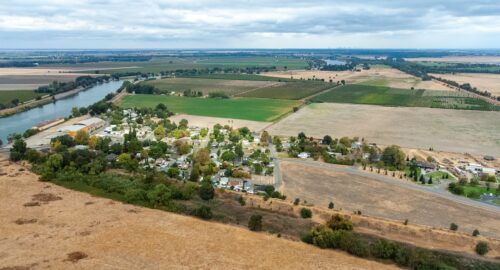
Paul Hames / DWR
“The Delta Legislative Caucus and the Delta Counties Coalition will be hosting an in-person meeting in the Delta regarding the Delta Tunnel on Tuesday, December 6, 2022, from 4:00 p.m. to 5:30 p.m., at the Willow Ball Ballroom, 10724 CA 160, Hood CA. The meeting will provide an overview of the $16-plus billion Delta Conveyance project, and provide an opportunity for the public to comment on the draft Environmental Impact Report (EIR). Comments on the EIR are due Friday, December 16, 2022. ... ” Read more from the Daily Kos here: In-person public comment meeting in Hood, CA will focus on Delta Tunnel project EIR
‘We have never had this bad a frost before’: April frost cut down this year’s Christmas tree crop in the Sierra
“For many families, it’s an annual tradition: driving into the Sierra Foothills to find that perfect Christmas tree. Dedrian Kobervig and her family have been growing Christmas trees in El Dorado County for over 20 years. Kobervig said that getting those trees ready for cutting is a bit like raising kids. “Once you get ’em to teenagers, they’re pretty much on their own,” she said, jokingly. Once Christmas trees are several years old, their root system is much more established. That makes the trees to be more tolerant to drought and other environmental stresses. … ” Read more from KCRA here: ‘We have never had this bad a frost before’: April frost cut down this year’s Christmas tree crop in the Sierra
Is the American West finally ready to kill the lawn?
“The Colorado River is drying up. This day has been coming since the agreement to divvy up its water was made exactly 100 years ago, signified most strikingly by lengthening white rings of mineral deposits left in wetter years tracing the shores around Lake Mead, the nation’s largest reservoir, now a slowly draining emerald-hued bathtub in the desert. The American Southwest’s worst drought in history has stressed every inch of the river’s 1,450-mile watershed, leaving a system so severely depleted that officials can no longer ignore the scientists who have been sounding the alarm for decades: There is no more water, and there is no more water coming. (At current use rates, the most generous estimates say there are four to six years left.) Staring down forecasts predicting yet another winter of exceptionally low snowpack levels, a consortium of 32 agencies that supply water to 40 million Americans living in both the driest and fastest-growing places in the U.S. have finally made a historic agreement to reduce water use — most significantly by setting a goal to decrease grass lawns throughout their service areas from Denver to Santa Monica by 30 percent. … ” Read more from Curbed here: Is the American West finally ready to kill the lawn?
State accepts applications for money to restore eroded beaches
“The California State Parks’ Division of Boating and Waterways is accepting grant applications for shoreline erosion control and public beach restoration projects. The deadline to submit applications for funding in fiscal year 2024/25 is Thursday, Dec. 15 by noon. Shoreline erosion control and public beach restoration grants assist federal, state, regional and local government agencies by providing money for projects that stop or reverse the impact of erosion on California’s shoreline. Generally, agencies use shoreline erosion control grants to build structures that protect public infrastructure in developed shoreline areas against wave erosion, and they use public beach restoration grants to strategically place sand on eroded beaches. … ” Read more from the Brentwood Press here: State accepts applications for money to restore eroded beaches
In commentary this weekend …
Creating water abundance in California
Edward Ring, contributing editor and senior fellow with the California Policy Center, writes, “Water is Life. For as long as there has been civilization, access to water has been an unyielding prerequisite. California is no exception. As its population grew, the state built one of the most remarkable systems of interbasin water transfers in the world. Every year, nearly 40 million acre feet of water is diverted from remote rivers and transported to magnificent coastal cities or used to irrigate rich farmland. But the whole system needs to be upgraded for the 21st century. Here are some water projects that ought to be moving forward in California … “ Read more from the Epoch Times here: Creating water abundance in California
In people news this weekend …
Promotions, passings, profiles – submit people news items to maven@mavensnotebook.com.
ACWA presents 2022 Emissary Award to Anjanette Shadley
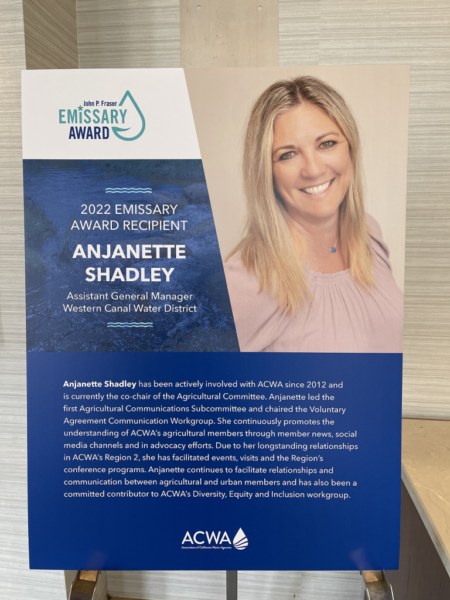 “The Association of California Water Agencies (ACWA) this week presented its 17th annual Emissary Award to Western Canal Water District Assistant General Manager Anjanette Shadley. Presented during ACWA’s 2022 Fall Conference & Exhibition in Indian Wells, the award recognizes individuals who have made remarkable contributions to California water through voluntary service to ACWA. Shadley has been actively involved with ACWA for more than a decade and is currently the co-chair of the association’s Agricultural Committee. “Anjanette Shadley has been a collaborative and thoughtful voice at ACWA, especially for our agricultural members,” said ACWA President Pamela Tobin. “Her dedication and engagement in working to promote ACWA’s goals at the local, regional and state levels are greatly appreciated and we are thrilled to be able to honor her for her contributions.” … ” Read more from the Northern California Water Association here: ACWA presents 2022 Emissary Award to Anjanette Shadley
“The Association of California Water Agencies (ACWA) this week presented its 17th annual Emissary Award to Western Canal Water District Assistant General Manager Anjanette Shadley. Presented during ACWA’s 2022 Fall Conference & Exhibition in Indian Wells, the award recognizes individuals who have made remarkable contributions to California water through voluntary service to ACWA. Shadley has been actively involved with ACWA for more than a decade and is currently the co-chair of the association’s Agricultural Committee. “Anjanette Shadley has been a collaborative and thoughtful voice at ACWA, especially for our agricultural members,” said ACWA President Pamela Tobin. “Her dedication and engagement in working to promote ACWA’s goals at the local, regional and state levels are greatly appreciated and we are thrilled to be able to honor her for her contributions.” … ” Read more from the Northern California Water Association here: ACWA presents 2022 Emissary Award to Anjanette Shadley
North Coast Water Board names new executive officer with deep ties to region
“The North Coast Regional Water Quality Control Board announced today that it has selected former two–term board member, Valerie Quinto, as its new executive officer to oversee its daily operations and serve as its principal advisor on water quality regulation and policy. Quinto, the executive director of the Sonoma Resource Conservation District who years ago interned at the regional board while studying biology at Sonoma State University, will start her new job on Jan. 17, 2023. She will succeed Matt St. John, who has been executive officer for over a decade and will be transitioning to a newly created role at the board addressing the complex challenges of climate change in the North Coast region. “Having Ms. Quinto stepping into this role assures that the agency will continue to provide leadership and stewardship of the North Coast’s precious waters,” said Greg Giusti, the regional board’s chair. … ” Read more at the State Water Board here: North Coast Water Board names new executive officer with deep ties to region
Sunday reads …
Imagining the Sacramento-San Joaquin River Delta: An Anthology of Voices Across Centuries
 “How would you describe California’s Delta, where our two great rivers, the Sacramento and the San Joaquin, mingle and linger on their way to the Bays and the Pacific Ocean? Would you tell of a sacred place of creation after a primeval flood? A place of astonishing natural riches? Would your story speak of a barrier to overland travel between the Bay Area and the plains of the Great Central Valley? Or would you tell of the watery highways that connected the three largest cities in early California: San Francisco, Sacramento City (gateway to the northern Sierra goldfields), and Stockton (the route to the southern placers)? … Would you reflect on heritage towns in the Delta? On exploring sleepy sloughs in a houseboat? Fishing and waterfowl hunting? Or would the role of our Delta as the kingpin of statewide water engineering first come to mind? It is difficult to capture the splendid complexity of the Sacramento-San Joaquin Delta with any one story. That’s why this anthology of writings from multiple viewpoints and eras and addressing diverse topics is so valuable. … ” Read more from Soundings here: Imagining the Sacramento-San Joaquin River Delta: An Anthology of Voices Across Centuries
“How would you describe California’s Delta, where our two great rivers, the Sacramento and the San Joaquin, mingle and linger on their way to the Bays and the Pacific Ocean? Would you tell of a sacred place of creation after a primeval flood? A place of astonishing natural riches? Would your story speak of a barrier to overland travel between the Bay Area and the plains of the Great Central Valley? Or would you tell of the watery highways that connected the three largest cities in early California: San Francisco, Sacramento City (gateway to the northern Sierra goldfields), and Stockton (the route to the southern placers)? … Would you reflect on heritage towns in the Delta? On exploring sleepy sloughs in a houseboat? Fishing and waterfowl hunting? Or would the role of our Delta as the kingpin of statewide water engineering first come to mind? It is difficult to capture the splendid complexity of the Sacramento-San Joaquin Delta with any one story. That’s why this anthology of writings from multiple viewpoints and eras and addressing diverse topics is so valuable. … ” Read more from Soundings here: Imagining the Sacramento-San Joaquin River Delta: An Anthology of Voices Across Centuries
Podcasts …
WORDS ON WATER PODCAST: Radhika Fox on EPA Water Work
Radhika Fox is Assistant Administrator for Water at the U.S. Environmental Protection Agency. In this episode, Radhika discusses a variety of issues that EPA is working on including infrastructure funding, water affordability, PFAS, and biosolids.
KPBS ROUNDTABLE: The state of San Diego’s water
This week, San Diego officials began lowering water levels at Lake Hodges to protect the dam which is undergoing repair work. What does it mean for San Diego’s water situation?
PLACE AND PURPOSE W/OBI KAUFMANN: December
Greg Sarris and Obi Kaufmann continue their live, video-podcast from Sonoma Mountain.
GOLDEN STATE NATURALIST: 2022 Conference highlights with Jose Gonzalez, Rhiana Jones, Obi Kaufmann, and more!
In regional water news this weekend …
SACRAMENTO VALLEY
Folsom Reservoir: Keeping water when and where we need it
“Founded at the confluence of the Sacramento and American rivers, Sacramento has long benefited from the rivers and lakes surrounding it. But while commerce, agriculture and recreation have flourished because of its access to sustainable water, the valley is also prone to flooding. To help protect the area, the Flood Control Act of 1944 authorized the building of Folsom Dam, completed in 1956. Since then, Folsom Reservoir has provided not just flood control, but municipal water supply to several communities, including the City of Roseville. “The City of Roseville has had a relationship through the federal government with Folsom Reservoir since 1971 (and) … it still remains our primary water supply,” says Sean Bigley, assistant environmental utilities director for the City of Roseville. “Folsom Reservoir was built as a flood control facility first and foremost, and that remains the primary purpose (but) … of course water supply is another significant purpose of that reservoir.” … ” Read more from the Sacramento News & Review here: Folsom Reservoir: Keeping water when and where we need it
NAPA/SONOMA
Group sues to halt logging near 2,000-year-old redwood on Russian River
“A group of tree lovers in Sonoma County has filed a lawsuit to block logging near a 2,000-year-old redwood tree on the banks of the Russian River. In late November, Cal Fire approved a timber harvest plan that would allow loggers to begin cutting select redwoods, firs and oaks on a 224-acre property near Guerneville. The site is home to the 340-foot Clar Tree — the tallest in the county — which has managed to avoid the ax even as the property has been logged three times in the past 25 years. … ” Read more from the SF Chronicle here: Group sues to halt logging near 2,000-year-old redwood on Russian River
BAY AREA
Storm brings plenty of water to the Bay Area, not enough to combat drought
“The Bay Area is gearing up for a weekend of constant rainfall and with the Friday storm, the ground is getting the saturation it needs. But experts warn this is still not nearly enough to get us over the hump, especially after they just announced it can’t help. Crews spent the day cleaning up Friday and the good news is that rain totals were significant for the Bay Area, the bad news is that, “Unfortunately, the drought is not over. Although we welcome the precipitation, much more is needed,” said Aaron Baker of Valley Water. Lexington Reservoir barely moved the needle this week, still at 34.5% of capacity. … ” Read more from NBC Bay Area here: Storm brings plenty of water to the Bay Area, not enough to combat drought
Answers to the most curious questions about the San Francisco Bay
“There are a few places as iconic as the San Francisco Bay Area. Its sweeping coastlines and varied microclimates have been capturing hearts and imaginations for thousands of years, ever since Indigenous people, including the the Ohlone, Bay Miwok, Muwekma, Yokuts and others made a home in its food-rich shores, hills and valleys more than 10,000 years ago. … The San Francisco Bay is made up of Pacific Ocean waters that flow through the Golden Gate, where it mixes with inland fresh water that has traveled coastward from the Sacramento and San Joaquin rivers in the Central Valley. Formed by the movement of tectonic plates 650,000 years ago, this natural harbor inspires much curiosity and many questions. “Are there sharks in the Bay?” “Can you swim in the Bay?” “But isn’t it really cold?” Here are all of your San Francisco Bay questions — and more — answered. … ” Read more from SF Gate here: Answers to the most curious questions about the San Francisco Bay
CENTRAL COAST
Regulator authorizes Cal Am to purchase future water supply
“A key state regulator on Thursday OK’d an agreement to have California American Water Co. buy future water from the planned Pure Water Monterey Expansion project. The agreement signals a major new water supply for the Monterey Peninsula. Mike McCullough, the director of external affairs for Monterey One Water (M1W), said the authorization defines the terms and conditions for the sale of water from the expansion project. Monterey One Water is the public wastewater agency operating the Pure Water Monterey recycled water project and which will operate the Pure Water Monterey Expansion. “Once that document is executed, Monterey One Water can finalize funding for construction of the expansion from the U.S. Environmental Protection Agency and open the bid process for construction of the expanded facilities,” McCullough said. … ” Read more from the Monterey Herald here: Regulator authorizes Cal Am to purchase future water supply
SAN JOAQUIN VALLEY
Dos Rios Ranch set to be newest California park
“At the point where the Tuolumne and San Joaquin rivers converge near Grayson, River Partners has been leading the decade-long effort to turn the clock back for the 2,100 acres at Dos Rios Ranch. What was a working dairy and almond orchard has been transformed into and environment resembling the natural habitat it once was, long before the soil was ever tilled. Dos Rios Ranch was designated in this year’s budget to become the first new state park created in California in more than a decade. It will also be the first state park accessible within Stanislaus County. River Partners is the largest riparian habitat and floodplain restoration group in California, having completed nearly 300 projects with another 50 under way. They began acquiring the Dos Rios property in 2011 when rancher Bill Lyons sold the Ranch. … “ Read more from Westside Connect here: Dos Rios Ranch set to be newest California park
$3.4 million grant awarded yesterday for safe water for West Goshen
“Thanks to tireless advocacy by community leaders, [last week] the Department of Water Resources awarded Tulare County a $3.4 million grant for the express purpose of connecting nearby West Goshen homes to a permanent and sustainable water source. West Goshen is a small, unincorporated community just west of Visalia in Tulare County. While a portion of the community gets safe drinking water from California Water Service — which also serves the city of Visalia — more than 50 households still rely on private wells. Families accessing water from their own wells face dual crises of water contamination and dropping groundwater levels leaving wells on the brink of failure. ... ” Read more from the Valley Voice here: $3.4 million grant awarded yesterday for safe water for West Goshen
SOUTHERN CALIFORNIA
Column: At DWP, the pay is good, the benefits are better and the deals keep getting sweeter
Columnist Steve Lopez writes, “More than once over the years, when people have complained about how hard it is to survive in a low-wage economy with such crippling healthcare costs, I’ve recommended they apply for work at the Los Angeles Department of Water and Power. I was reminded a few days ago, as terms of the new DWP contract were revealed, that this is still solid advice. And there’s more good news: the utility, never far removed from scandal, is hiring. In a story by Dakota Smith, The Times reported that Mayor Eric Garcetti was backing a handsome pay hike for water and power employees after an 11-0 vote by the Los Angeles City Council. … ” Read more from the LA Times here: Column: At DWP, the pay is good, the benefits are better and the deals keep getting sweeter
Local scientist gives future drought forecast for Malibu
“Last summer, Malibu residents were urged to conserve water for several weeks during a severe water shortage — but many ignored the warnings and continued watering their grass lawns — apparently not taking the warnings seriously. This rainy season, the four-year drought is expected to continue — a weather pattern that’s becoming the new normal due to global warming. It’s the desertification of Southern California. There have been a number of predictions of water shortages affecting our entire region, but what about Malibu specifically? Malibu resident Madelyn Glickfeld gave us her take on why Malibu is unique and needs to be more aware and worried about future water supplies than it is. … ” Read more from the Malibu Times here: Local scientist gives future drought forecast for Malibu
In historic move, Los Angeles bans new oil wells, phases out existing ones
“The Los Angeles City Council voted Friday to phase out all oil drilling in L.A. and ban new wells, a historic move in a city that was built by a once-booming petroleum industry and whose residents have suffered with decades of environmental consequences as a result. In a 12-0 vote, the council approved a new ordinance that immediately bans new oil and gas extraction and requires that all existing oil and gas extractions stop production within 20 years. The move is opposed by the oil industry, whose leaders warned city officials that the phase-out will hurt the city’s finances and make L.A. more dependent on foreign oil. … “ Read more from the LA Times here: In historic move, Los Angeles bans new oil wells, phases out existing ones
SAN DIEGO
Commentary: San Diego is not protected from California’s severe water supply crisis
“California’s water supply crisis has hit a tipping point, with impacts spreading far and wide, reaching local communities and critical industries, putting us once again in jeopardy. This is a pivotal moment in the state’s future – one in which bold political leadership will emerge, or future generations will suffer. … San Diego water agencies have instituted conservation programs and improved local infrastructure and operations, reducing our water use by 30 percent from 1990 to 2020. But despite the tremendous local conservation efforts and investments in our regional water resources and infrastructure, climate change and radical changes in critical State Water Project and Colorado River water supplies have put our region at risk and potentially subject to mandatory water supply cutbacks.. … ” Read more from the Voice of San Diego here: Commentary: San Diego is not protected from California’s severe water supply crisis
Along the Colorado River …
Reclamation makes operational adjustments from Lake Powell to protect low level critical elevations
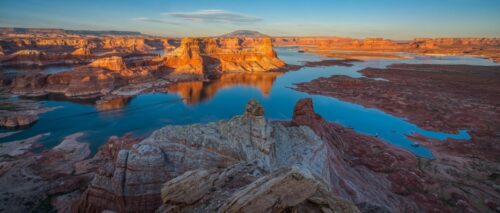
“The Bureau of Reclamation has begun monthly operational adjustments with reduced releases from Glen Canyon Dam under the Drought Response Operations Agreement. The adjusted releases are designed to help protect critical elevations at Lake Powell until the spring runoff materializes. The monthly adjustments will hold back 523,000 acre-feet of water in Lake Powell from December 2022 through April 2023 when inflow to the reservoir is low. The same amount of water (523,000 acre-feet) will then be added to releases to Lake Mead between June and September after the spring runoff occurs. … ” Read more from the Bureau of Reclamation here: Reclamation makes operational adjustments from Lake Powell to protect low level critical elevations
Commentary: Arizona thinks ocean desalination will bring it the water it needs. It won’t
Robert Glennon, a Regents Professor Emeritus at the University of Arizona College of Law, and Brent M. Haddad, Ph.D., Professor of Environmental Studies at U.C. Santa Cruz, write, “The allure of seawater desalination seems irresistible. All that ocean water just waiting to have the salt removed and be delivered to your tap. It can be done, but there are three hurdles: It’s costly. It’s energy intensive. And it creates a need to dispose of the leftover salt. Gov. Doug Ducey’s State of the State address in January, followed by enactment of Senate Bill 1740 in July, pledges more than $1 billion over three years to bring more water to Arizona. The cornerstone is a proposal to desalinate water from Mexico’s Sea of Cortez. Construction cost estimates for this project range from $3 to $4 billion. That’s a lot of money – more than Arizona contributed to funding the Central Arizona Project. Yet, the estimates woefully understate the state’s ultimate liabilities. There are other, much less expensive options that would provide a secure supply. … ” Read more from the Arizona Central here: Commentary: Arizona thinks ocean desalination will bring it the water it needs. It won’t
Western water leaders talk local solutions amid Colorado River crisis
“Some water leaders in the West are working on local solutions as the Colorado River Basin faces historic drought. The Water Hub, a national organization centered on water justice, led a briefing with a team of panelists to talk about some of them. “The river has been in the news and in the public eye … but a lot of that coverage has focused on the current crisis,” said Nicole Lampe, the managing director of the Water Hub. “But we know that interim solutions aren’t enough to bring the basin back to health. That’s why we’ve convened this great panel of expert practitioners to talk about the opportunity now, with billions in federal funding to rehydrate the landscape, with nature-based projects.” … ” Read more from KUNC here: Western water leaders talk local solutions amid Colorado River crisis
Audio: Southern Nevada Water Authority’s latest moves to protect Colorado River system
“In January, rate hikes are coming to water users in southern Nevada. In December, a major water conference will be held in Las Vegas. In October, the Department of the Interior announced it wants to change federal rules so it can regulate use of Colorado River water. This came after the seven states using that water failed to come to agreement in August. And if you read the Washington Post online yesterday, it had an almost apocalyptic story dire circumstances in the not-so-distant future as the river keeps falling. More than 20 years of drought is hitting the river hard. 40 million people depend on that water. About 2.3 million of those are in southern Nevada. John Entsminger manages the system as the general manager of the Southern Nevada Water Authority.” Listen at KNPR here: Audio: Southern Nevada Water Authority’s latest moves to protect Colorado River system
Commentary: Local Opinion: The Colorado River won’t obey our rules
Karl Flessa, emeritus professor of geosciences at the University of Arizona, writes, “The Colorado River Compact is 100 years old. A University of Arizona conference and the upcoming Colorado River Water Users Association will mark the anniversary. But there’s no reason to celebrate. Twenty-two years into a drought and with reservoirs at all-time lows, the federal government may soon intervene in the states’ management of the river. The Compact has failed. Don’t blame the river. We need a new system that manages with the river and provides all users with fair shares. … ” Read more from the Arizona Daily Star here: Commentary: Local Opinion: The Colorado River won’t obey our rules
Colorado’s soil moisture is better than in recent years. But that’s not saying much
“Fall soil conditions across the Upper Colorado River Basin are not as dry as in the past few years, but the amount of moisture packed into the dirt heading into winter is still below long-term averages, according to new modeling from the Colorado Basin River Forecast Center. “Across many of the major contributing areas, the higher elevation areas that generate the most runoff, our model soil moisture conditions are near to below normal,” said Cody Moser, a senior hydrologist at the forecast center. Soil moisture this time of year is an important factor for water managers who study weather conditions for a sense for how much runoff to expect in the spring. After a particularly wet 2019, the past two years have been hotter and drier across the West; those conditions dried out the soil, which then sucked up valuable snow melt before it ever made its way into a river or stream. … “ Read more from the Durango Herald here: Colorado’s soil moisture is better than in recent years. But that’s not saying much
In national water news this weekend …
Congress passes bill to block rail strike, ensuring access to water treatment chemicals
“The U.S. House of Representatives and Senate have both approved legislation to block the threat of a national rail strike that would affect the water industry’s access to essential water treatment chemicals. The legislation is expected to be quickly signed by President Biden, rendering any planned strike illegal. The labor dispute, between several U.S. rail carriers and 12 rail unions representing 125,000 workers, centers on working conditions including paid sick leave. If an agreement is not reached by as early as Dec. 9, rail service could be heavily disrupted by strikes. Disruption to rail service could have immense economic consequences and could harm access to water treatment chemicals. The legislation forces the unions to accept a tentative agreement and makes striking illegal. … “ Read more from Water World here: Congress passes bill to block rail strike, ensuring access to water treatment chemicals
The Cold War legacy lurking in U.S. Groundwater
“In America’s rush to build the nuclear arsenal that won the Cold War, safety was sacrificed for speed. Uranium mills that helped fuel the weapons also dumped radioactive and toxic waste into rivers like the Cheyenne in South Dakota and the Animas in Colorado. Thousands of sheep turned blue and died after foraging on land tainted by processing sites in North Dakota. And cancer wards across the West swelled with sick uranium workers. The U.S. government bankrolled the industry, and mining companies rushed to profit, building more than 50 mills and processing sites to refine uranium ore. But the government didn’t have a plan for the toxic byproducts of this nuclear assembly line. Some of the more than 250 million tons of toxic and radioactive detritus, known as tailings, scattered into nearby communities, some spilled into streams and some leaked into aquifers. … ” Read more from Pro Publica here: The Cold War legacy lurking in U.S. Groundwater

